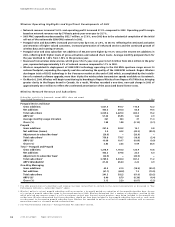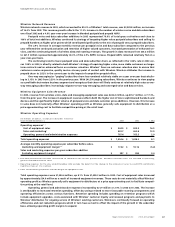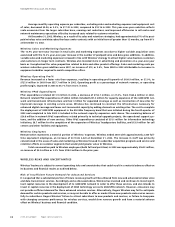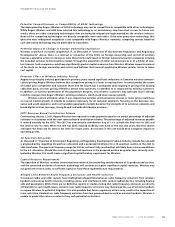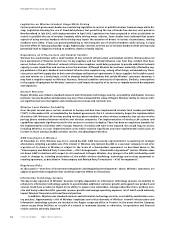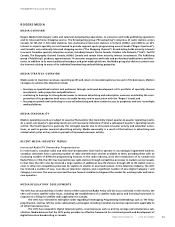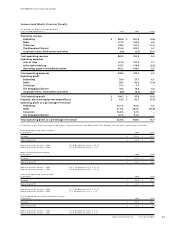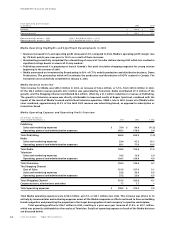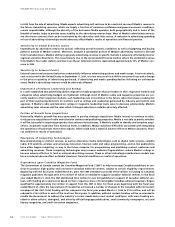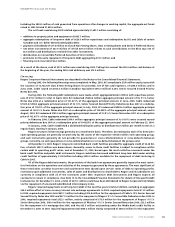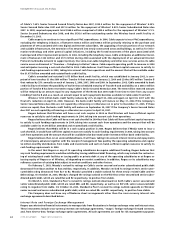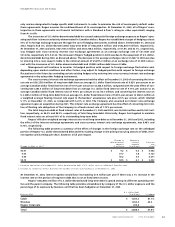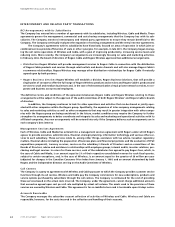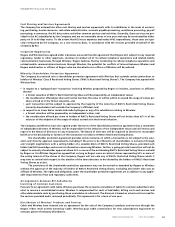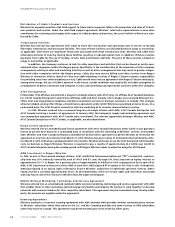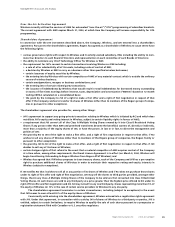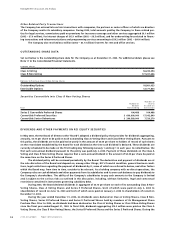Rogers 2003 Annual Report Download - page 58
Download and view the complete annual report
Please find page 58 of the 2003 Rogers annual report below. You can navigate through the pages in the report by either clicking on the pages listed below, or by using the keyword search tool below to find specific information within the annual report.
2003 Annual Report Rogers Communications Inc.
56
in 2003 from the sale of advertising. Media expects advertising will continue to be a material source of Media’s revenue in
the future. Advertising revenues, which are largely a function of consumer confidence and general economic conditions,
remain unpredictable, although the diversity of the businesses Media operates, both geographically and in terms of the
breadth of media, helps to provide some stability to the advertising revenue base. Most of Media’s advertising contracts
are short-term contracts that can be terminated by the advertiser with little notice. A reduction in advertising spending
or loss of advertising relationships would adversely affect Media’s results of operations and financial position.
Sensitivity to Global Economic Cycles
Expenditures by advertisers tend to be cyclical, reflecting overall economic conditions as well as budgeting and buying
patterns outside of Media’s control. Moreover, because a substantial portion of Media’s advertising revenue is derived
from local advertisers, Media’s ability to generate advertising revenue in specific markets is adversely affected by local or
regional economic downturns. This is particularly true in the concentrated Toronto market, where the combined revenue
from Media’s four radio stations and two over-the-air television stations represented approximately 14% of Media’s rev-
enue in 2003.
Sensitivity to External Events
External events and consumer behaviour substantially influence advertising patterns and media usage. A terrorist attack,
such as occurred in the United States on September 11, 2001, or a war may result in a shift in consumer focus and a change
in the price or quantity of advertising purchased. If advertising and media spending decline following an unforeseen
event, Media’s advertising revenues could be adversely affected.
Importance of Industry Leadership and Ratings
It is well established that advertising dollars migrate to media properties that are leaders in their respective markets and
categories when advertising budgets are tightened. Although most of Media’s radio and magazine properties are cur-
rently leaders in their respective markets, such leadership may not continue in the future. Advertisers base a substantial
part of their purchasing decisions on statistics such as ratings and readership generated by industry associations and
agencies. If Media’s radio and television ratings or magazine readership levels were to decrease substantially, Media’s
advertising sales volumes and the rates which it charges advertisers could be adversely affected.
Portion of Growth from Acquisitions
Historically, Media’s growth has been generated, in part by strategic acquisitions. Media intends to continue to selec-
tively pursue acquisitions of radio and television stations and publishing properties. Media is not able to predict whether
it will be successful in acquiring properties that enhance its businesses. If Media is unable to identify and complete acqui-
sitions, its growth could slow from historical levels. In addition, Media could face difficulties associated with integrating
the operations of businesses that it does acquire, which could have a material adverse effect on Media’s business, finan-
cial condition or results of operations.
Emergence of Competing Technologies
New programming or content services, as well as alternative media technologies, such as digital radio services, satellite
radio, DTH satellite, wireless and wired pay television, Internet radio and video programming, and on-line publications
have either begun competing, or may in the future compete, for programming and publishing content, audiences and
advertising revenues. These competing technologies may increase audience fragmentation, reduce Media’s ratings or
have an adverse effect on its local or national advertising revenue. These or other technologies and business models may
have a material adverse effect on Media’s business, financial conditions or results of operations.
Dependency upon Canadian Magazine Fund
The Government of Canada created the Canadian Magazine Fund (“CMF”) to help encourage Canadian publishers to con-
tinue to produce high-quality and innovative Canadian editorial content, subject to certain eligibility requirements.
Beginning with the fiscal year ended March 31, 2001, the CMF intended to provide $150.0 million in funding to Canadian
magazine publishers through 2003, $75.0 million of which is intended to support Canadian editorial content. In the fiscal
year ended March 31, 2002, the CMF distributed $25.0 million to over 400 publishers in support of Canadian editorial con-
tent, with funding pro-rated across based on their respective share of total eligible Canadian editorial expenses. Rogers
qualified for approximately $5.0 million in support from the CMF in 2002. For fiscal years beginning with the fiscal year
ended March 31, 2004, the Government of Canada has announced a number of changes to the Canadian editorial content
envelope of the CMF. Total funding will be reduced in the fiscal year ended March 31, 2004 to $18.0 million and will be
reduced to $16.0 million in each of the next two fiscal years. In addition, editorial content funding will be re-oriented to
enable the Government to address the industry’s current needs and current market conditions, with more funding pro-
vided to ethno-cultural, aboriginal, and minority official-language publications, small community newspapers, arts and
literary magazines, and small-circulation magazines.
Management’s Discussion and Analysis


